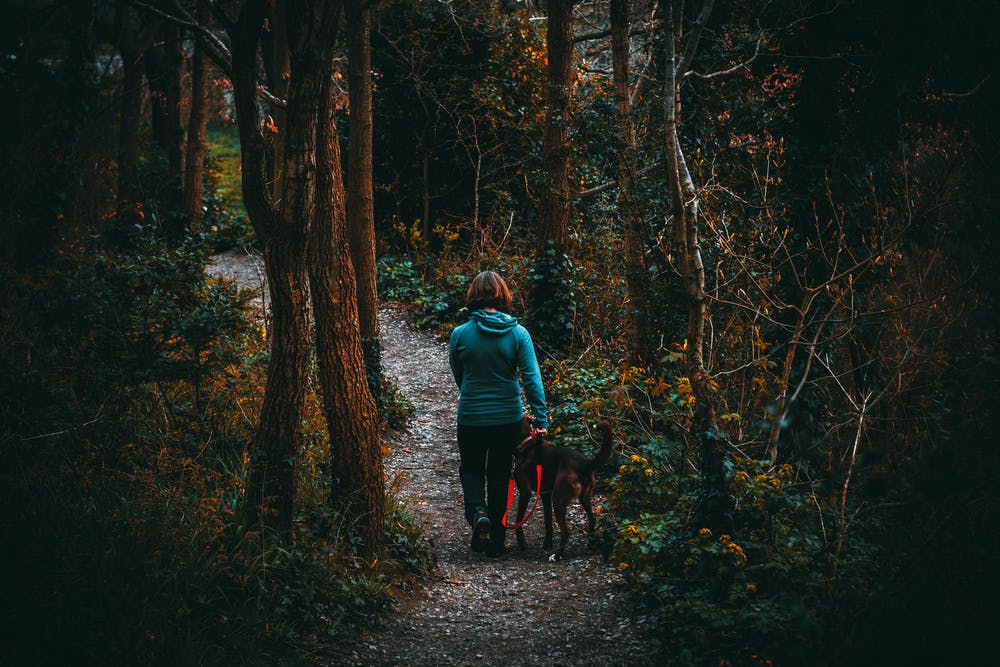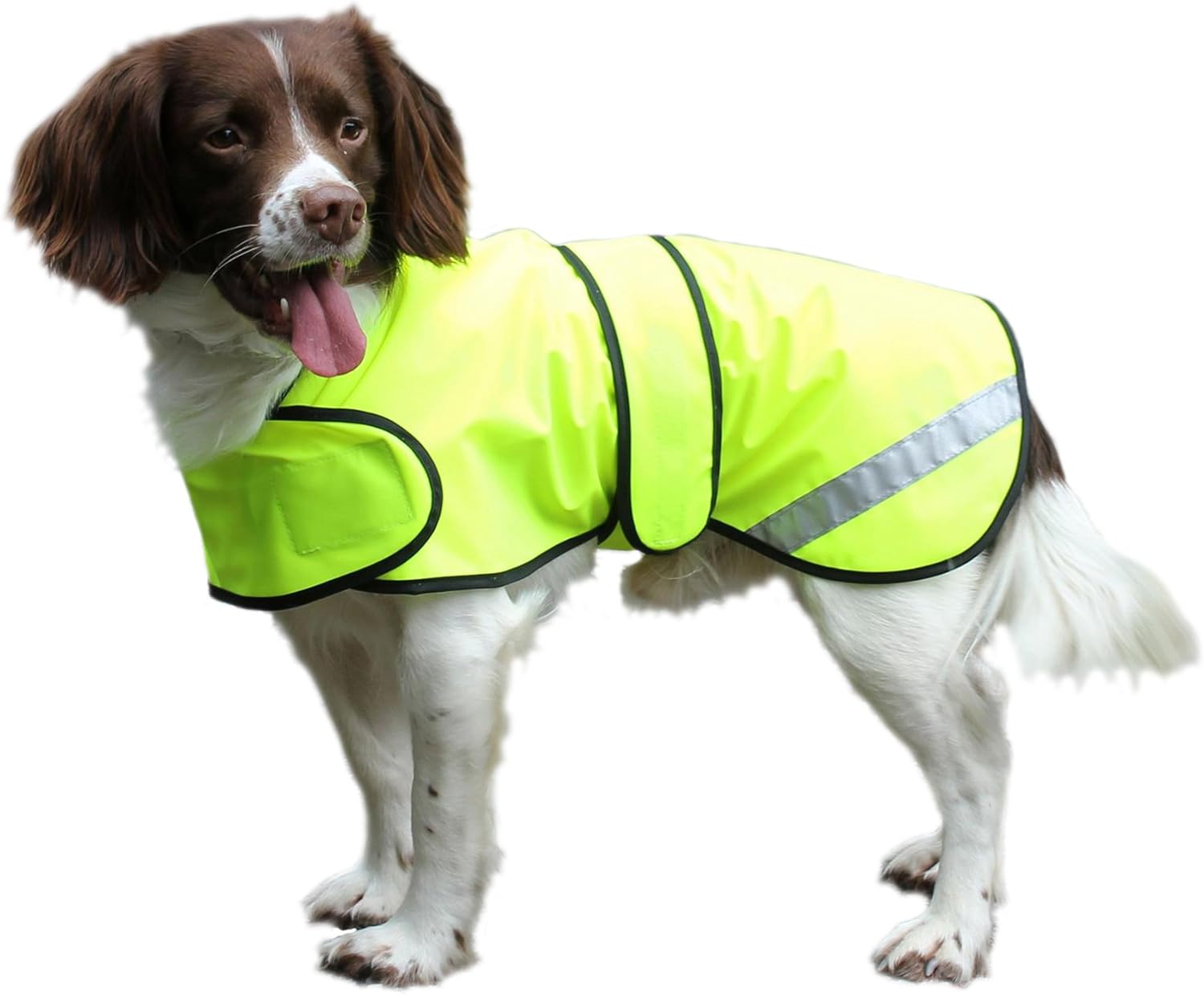How to walk your dog safely at night
Back
Walking your dog can be challenging in the autumn and winter months, as the temperatures start to drop, the weather can be more unpleasant and it starts to get darker earlier. As the nights grow longer it can be hard to know when to walk your dog safely, and if walking in darkness cannot be avoided, how best to do it in a way that is safe (and fun) for you and your dog.
Why is it harder to walk your dog at night?
The primary issue of walking at night is the lack of visibility in darkness. It can be tricky to walk your dog in the dark for several reasons, not only does it make it harder for you to see your dog, but it is also harder for your dog to see you. That is without taking into account other potential hazards (who may also not be able to see you) such as drivers, joggers, cyclists and other dog walkers. With the different night time wildlife and goings on your dog might be more distracted or likely to follow his nose than stick by your side.
Depending on where you live and where you walk you might also have concerns for your own personal safety when walking at night, in this scenario you could find yourself more susceptible to crime, as well as more likely to fall or trip on slippery pavements or down rabbit holes and injure yourself. What is more if the worst should happen and you or your dog should get injured, it is likely to be outside of working doctors and vets hours meaning that getting medical assistance could take longer than normal.
Can dogs see in the dark?
Dogs do see much better than humans in the dark due to the design of their eyes, however, this does not make them invincible in the darkness and additional measures should always be taken to keep them safe. Dogs have bigger pupils than humans which lets in more light. They also have more rods in their retinas and a tapetum behind the retina which reflects light, increasing the brightness and making them better equipped to deal with low light situations.
It is important to remember that just because your dog can see better in the dark than you can, that you must never take this for granted. Their improved vision (coupled with their sense of smell) could make them more likely to chase after something, be spooked or to run off into the darkness which could result in them getting lost or. even worse and accident.
Is it possible to walk my dog safely at night?
You should be able to walk your dog safely at night, taking the additional precautions below should help. It is important to point out that some dogs are afraid of the dark and sometimes the dark can make other fears, such as loud noises, worse. You should never force your dog to walk and if your dog is scared of the dark you should undertake additional training to help them to conquer this fear, always be patient with them and never punish them. Make sure that you train them at their own pace and only progress to walk at night once they are entirely comfortable with it.
How can I walk my dog safely at night?
-
Always use a lead- this will help your dog to feel secure as they will be able to feel that you are with them at all times which reduces the risk of them bolting off into the darkness. From your perspective it also gives you more control should they make any sudden movements. We would advise against using flexi leads for this purpose as this will reduce the control that you have, it will also hinder your sense of which direction the dog is walking in and therefore could mean that you are more at risk of tripping over the lead or falling.
-
Increase visibility- this goes for both you and your dog, recognising that it is equally important for your dog to be able to see you as it is for you and others to see your dog. You can choose to do this through bright clothing, reflective clothing or strips or by using LED lights, torches (or head torch) or a combination of the three.
-
Take a familiar route (ideally in lit areas)- It is preferable for you and your dog to take a route that you know, this drastically reduces the risks all around and your dog should be more familiar and able to track the scents that he is more familiar with (rather than bolting after new ones). Ideally it is best to walk along a lit route, but you should use a torch and/or reflective clothing for you and your dog as well, and especially do so if the route is not lit.
-
Traffic/vehicles- Ensure that you walk against traffic and keep to the pavement where you can, listen so that you can hearing approaching cars and ensure that you and your dog are outside of harms way. Ensure that you are both wearing lights and reflective gear so that traffic and cyclists can see you too and give you space. If you are wearing a head lamp try to make sure that you don't look directly at traffic or passers (and keep your head pointed to the floor) so as not to blind them on their way past, potentially causing an accident.
-
Take your phone - and make sure that someone knows where you are and how long you will be. Not only could your phone prove vital in the case of an emergency, most phones often have additional features such a torch, GPS tracking and navigational tools. It is also worth ensuring that you have apps such as What3Words which can help emergency services to pinpoint your location in the case of an emergency (especially if you do not know the name of the specific location you are in).
-
Be aware of your surroundings- never be tempted to wear headphones, make sure that you walk against traffic and stay on the pavement if possible. Take in your surroundings and this means that you are more likely to avoid any potential threats and to respond to any problems more readily.
-
Ensure that your dog is microchipped and that it's details are up to date. This will give you peace of mind if the worst case scenario should happen and your dog is to bolt when hearing a loud noise that spooks them. In April 2016 it became a legal requirement to microchip your dog.
Additional steps to help you to walk your dog at night
-
Dress for the weather- remember that it isn't only the dark that can be a threat during the autumn and winter, but also the cold as well as changing weather conditions. Being familiar with the route can help so that you know how far you have to walk if you need to get back unexpectedly. Ensure that you are wearing suitable clothing and shoes for the conditions and ensure that your dog is suitably equipped according to their specific needs.
-
Night Wildlife- be prepared that you might see some different wildlife such as foxes and badgers and bear in mind that your dog may react to them differently to a human, especially if they are a more nervous dog.
-
Walk with a friend- safety in numbers is a real thing and can help to make it an experience that you look forward to, just by knowing that you have back up. This might be a friend, neighbour or spouse.
-
Glow in the dark dog toys- these can really help to make night time walking fun for your dog and can really help to reinforce it as something your dog looks forward to.
-
Identifying other ways of exercise- if night time walking really is an issue for you or your dog for whatever reason, you might also want to consider alternatives such as walking them during the daytime (or getting a dog walker or using a dog day care centre where this is not an option) or dog agility classes (with are generally lit if they take place in the evening).
Best reflective gear for dogs
Reflective gear
| Cosipet Safety Coat £13.35 |
| Truelove Dog Reflective Dog Harness £22.89 |
| Ruffwear Safety Jacket for Dogs £43.95 |
LED lights
| Derlights LED Dog Collar Light, USB Rechargeable, Waterproof (2 pack) £10.99 |
| Morpilot Dog Collar Light (6 pack) Different Colours |
| Aluminium Pet LED Safety Light for Collar £6.60 |
LED collars
| Illumiseen LED Dog Collar £14.99 (Different colours and sizes available) |
LED Leads
| Illumiseen LED Dog Lead £23.99 (Different colours and lengths available) |
| Ultra Blue LED Dog Lead £17.99 |
Dog Coats
| Ancol Muddy Paws Stormguard Dog Coat, Large £14.70 |
| Cold Winter Dog Coat £14.95 |
| Penivo Cold Weather Reflective Dog Coat £20.98 |
Glow in the dark dog toys
| Chuckit Max Glow in the dark balls, Medium, 2 pack £11.15 |
| AB Tools Glow in the dark Football with squeaker £8.70 |
| Chuckit Max Glow Pro Launcher £15.03 |
| Chuckit CI Zipflight Max Glow in the dark Frisbee £9.52 |
Best reflective gear for dog walkers
Torch
| LED USB Charging Torches (2 pack) £11.99 |
| Battery Operated Waterproof LED Torch (AAA Batteries included) |
Reflective vest
| Blackrock Men's High Visibility Waistcoat £2.60 |
| Result Core Ladies Hi Visibility Vest £6.09 (available in pink, yellow or green) |
| Children's High Visibility Vest £3.29 |
Headlamp
| LED Head Torch (USB charging) £17.99 |
| LED Head Torch (Battery Charging-batteries included) £13.97 |
Reflective strips
| Brilliant Reflective Stick-On Tape (8 strips) £9.99 |
| LED Armband (4 pack) £7.99 |
| Slap-on Reflective Armbands (8 pack) £8.50 |
See also:
How to desensitise your dog to loud noises: Preparing your dog for fireworks night
What do I need to buy for my new dog?
Best Products to help walk your dog at night
Similar Articles

Good Dogs. Good Kennels.
The Good Kennel Guide takes the stress out of dog boarding by only listing licensed kennels and boarders who meet the standards required by the Animal Licensing (Licensing of Activities Involving Animals) Regulations 2018.
All kennels and boarders that hold a valid licence have a free listing on the website which kennel owners and boarders can “claim” by creating a free account - this allows them to personalise some of their listing and interact with dog owners.

An easy-to-use system for dog owners
The Good Kennel Guide takes the stress out of dog boarding by only listing licensed kennels and boarders who meet the standards required by the Animal Boarding Act 1963.
Dog owners can sign up and create a profile here - it's really simple, and only takes a few moments.
Add your dog to your private profile to submit enquiries to kennel owners and boarders, send messages, and leave reviews following boarding.
Kennel Locations
England
Airports
























